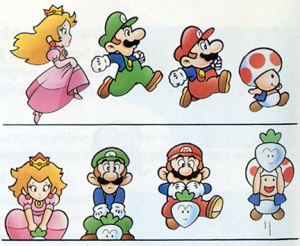
The game takes place in a new location named Sarasaland where Mario has to rescue Princess Daisy from danger. The game has 4 levels with 3 stages ranging from the typical outside levels, the caves, underwater, and the sky. The sky levels and underwater levels had a bit of a twist with Mario riding a submarine and airplane taking down the enemies. The powerups remained the same with the mushroom, fire flower, and star, but the fire flower bounced around and the star's music was changed to the Can-Can song. There was a 1-Up in the game, but it was the shape of a heart to differentiate from the mushroom. Since the original Game Boy didn't have color back then, they had to change the shape of the 1-Up, which makes sense. The designs of the worlds are a bit different than previous Mario games with pyramids, decorative hieroglyphs on the walls of the underground caves, Easter Island heads, and more.


The game became one the best selling games on the Game Boy and one of the best selling Mario games of all time selling 18 million copies. It even beat the sales of Super Mario Bros. 3. However, the game received positive reviews saying about how the game was able to capture the simplicity charm of the console Mario games on a handheld to how it was great that a game that fun could be convenient to take on the go. However, other critics had mixed reactions saying that the game was too short, easy, and the screen was tired and cramped after playing a few minutes in. Yes, there are some flaws in the game with the very loose controls, floaty jumping mechanics, strange looking levels, and the fact that it took me only 35 minutes to beat it. But there are some positives in this game: some of the levels are memorable, the submarine and airplane levels are very unique and something you don't see in Mario games, and the soundtrack is amazing. With this being one of the first games ever made for the Game Boy, the developers didn't know how far they could push the Game Boy when creating it. Other games later on would utilize the Game Boy's limited space to create other more complex games, one of which we'll discuss another time.

Overall, the game has some problems, but it's still a good game that I would recommend checking out. That's all for now. Tune in next time as we'll be jumping into 16 bit with Super Mario World.

That's all for now. Hope to see you around Old School Lane soon. Thanks for reading.
-Patricia


The game became one the best selling games on the Game Boy and one of the best selling Mario games of all time selling 18 million copies. It even beat the sales of Super Mario Bros. 3. However, the game received positive reviews saying about how the game was able to capture the simplicity charm of the console Mario games on a handheld to how it was great that a game that fun could be convenient to take on the go. However, other critics had mixed reactions saying that the game was too short, easy, and the screen was tired and cramped after playing a few minutes in. Yes, there are some flaws in the game with the very loose controls, floaty jumping mechanics, strange looking levels, and the fact that it took me only 35 minutes to beat it. But there are some positives in this game: some of the levels are memorable, the submarine and airplane levels are very unique and something you don't see in Mario games, and the soundtrack is amazing. With this being one of the first games ever made for the Game Boy, the developers didn't know how far they could push the Game Boy when creating it. Other games later on would utilize the Game Boy's limited space to create other more complex games, one of which we'll discuss another time.

Overall, the game has some problems, but it's still a good game that I would recommend checking out. That's all for now. Tune in next time as we'll be jumping into 16 bit with Super Mario World.

That's all for now. Hope to see you around Old School Lane soon. Thanks for reading.
-Patricia









